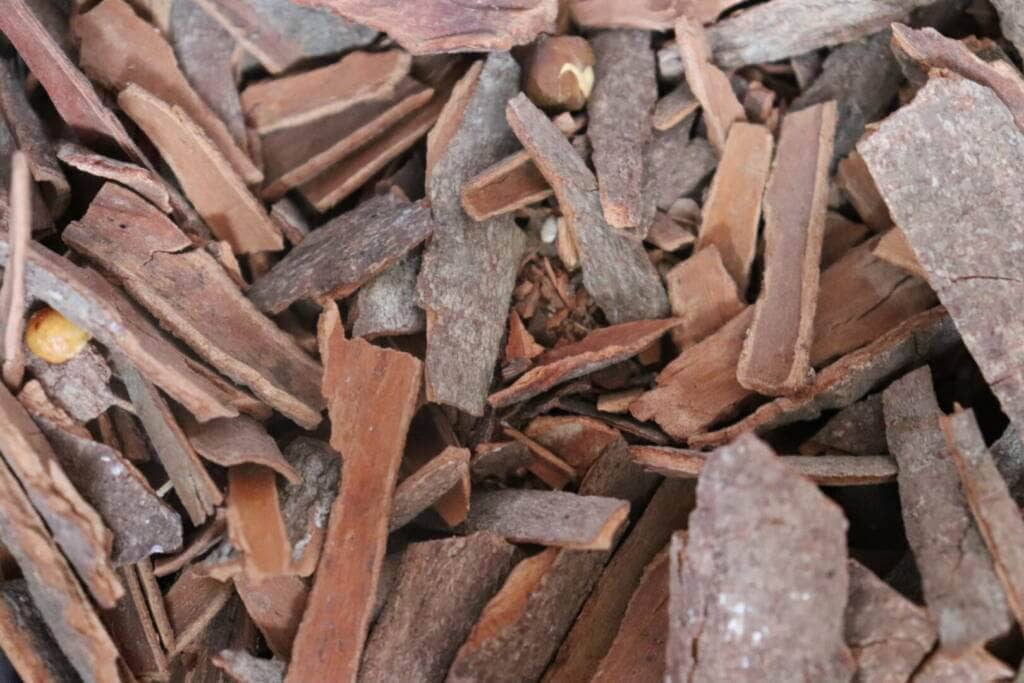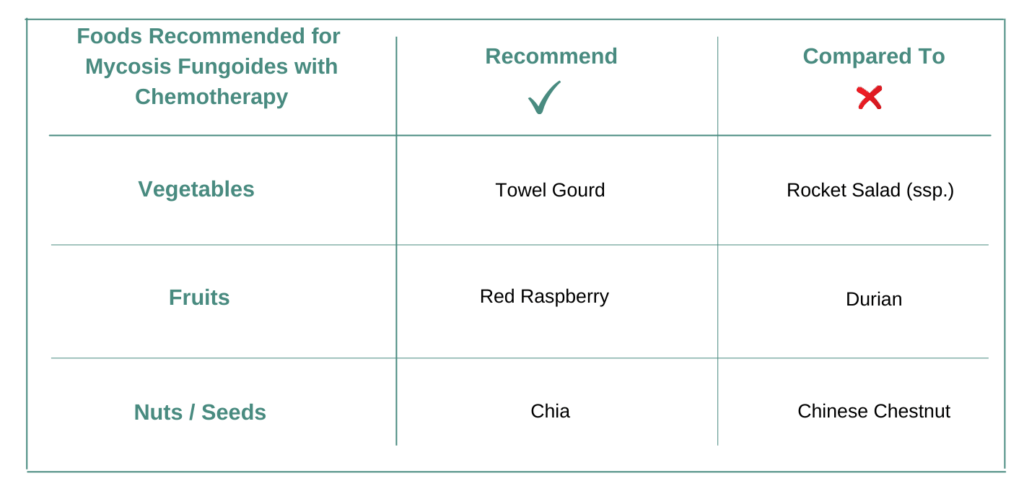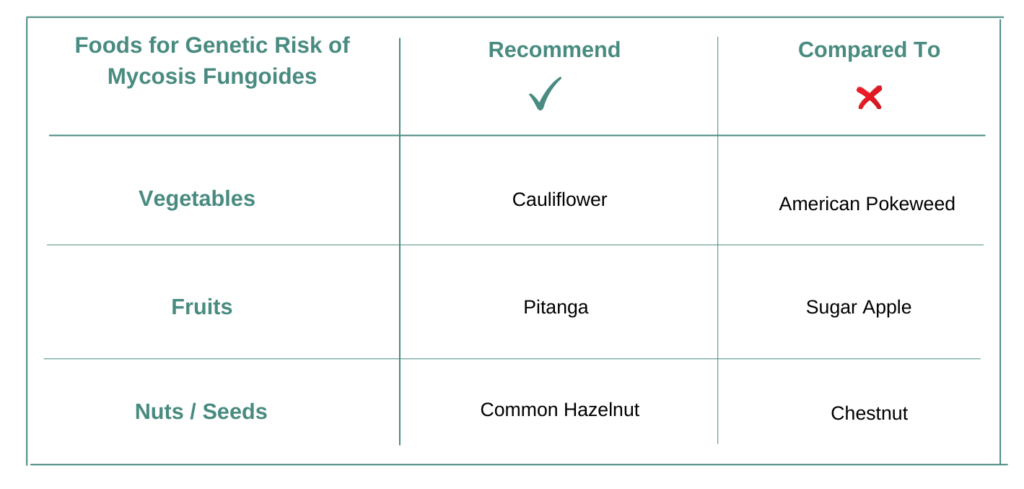Introduction
Foods for Mycosis Fungoides should be personalized for each individual and also must adapt when cancer treatment or tumor genetic change. The personalization and adaptation must consider all the active ingredients or bioactives contained in different foods with respect to cancer tissue biology, genetics, treatments, lifestyle conditions and diet preferences. Hence while nutrition is one of the very important decisions for a cancer patient and individual at risk of cancer to make – how to choose foods to eat is not an easy task.
Mycosis fungoides is a slowly progressive and chronic disease, a rare form of T-cell lymphoma of the skin. In individuals with mycosis fungoides, the skin becomes infiltrated with plaques and nodules composed of lymphocytes. This disorder can spread to other parts of the body including the liver, spleen, gastrointestinal system, or brain. Mycosis fungoides occurs in adults over 40 years of age and has a predominance in males over females. Symptoms of mycosis fungoides can include flat, scaly patches; thicker raised lesions (plaques); and common skin conditions like eczema or psoriasis along with excessive itching. Mycosis fungoides patients can have long-term remission with treatment, and many may live with minimal or no symptoms for many years. Most patients diagnosed with mycosis fungoides live with early-stage disease and have a normal life span. Treatment for mycosis fungoides include skin directed therapies such as creams, ointments or gels, and systemic therapies with chemotherapy, targeted agents or immunotherapies. Additionally, supportive care with the right nutrition (food and natural supplements) with their inherent bioactives that can interfere with the disease-causing pathways, can enhance patients’ well-being.
For Mycosis Fungoides does it matter what vegetables, fruits, nuts, seeds one eats?
A very common nutrition question asked by cancer patients and individuals at-genetic risk of cancer is – for cancers like Mycosis Fungoides does it matter what foods I eat and which I do not? Or if I follow a plant-based diet is that enough for cancer like Mycosis Fungoides?
For example does it matter if vegetable Towel Gourd is consumed more compared to Rocket Salad (ssp.)? Does it make any difference if fruit Durian is preferred over Red Raspberry? Also if similar choices are made for nuts/seeds like Chia over Chinese Chestnut and for pulses like Yardlong Bean over Gram Bean. And if what I eat matters – then how does one identify foods which are recommended for Mycosis Fungoides and is it the same answer for everyone with the same diagnosis or genetic risk?
Yes! Foods you eat matters for Mycosis Fungoides!
Food recommendations may not be the same for everyone and can be different even for the same diagnosis and genetic risk.

All foods (vegetables, fruits, nuts, seeds, pulses, oils etc.) and nutritional supplements are made up of more than one active molecular ingredient or bio-actives in different proportions and quantities. Each active ingredient has a unique mechanism of action – which can be activation or inhibition of different biochemical pathways. Simply stated foods and supplements which are recommended are those which do not cause an increase of molecular drivers of cancer but reduce them. Else those foods should not be recommended. Foods contain multiple active ingredients – hence when evaluating foods and supplements you need to consider the impact of all active ingredients cumulatively rather than individually.
For example Durian contains active ingredients Cinnamaldehyde, Daidzein, Lupeol, Phloretin, Lycopene. And Red Raspberry contains active ingredients Daidzein, Cinnamaldehyde, Lupeol, Beta-cryptoxanthin, Phloretin and possibly others.
A common mistake made when deciding and choosing foods to eat for Mycosis Fungoides – is to evaluate only selected active ingredients contained in foods and ignore the rest. Because different active ingredients contained in foods may have opposing effects on cancer drivers – you cannot cherry pick active ingredients in foods and supplements for making a nutrition decision for Mycosis Fungoides.
YES – FOOD CHOICES MATTER FOR CANCER. NUTRITION DECISIONS MUST CONSIDER ALL ACTIVE INGREDIENTS OF FOODS.
Skills Needed for Nutrition Personalization for Mycosis Fungoides?
Personalized nutrition for cancers like Mycosis Fungoides consists of recommended foods / supplements; not recommended foods / supplements with example recipes which prioritize use of recommended foods. An example of personalized nutrition can be seen at this link.
Deciding which foods are recommended or not is extremely complicated, requiring expertise in Mycosis Fungoides biology, food science, genetics, biochemistry along with good understanding of how cancer treatments work and associated vulnerabilities by which the treatments could stop being effective.
MINIMUM KNOWLEDGE EXPERTISE NEEDED FOR NUTRITION PERSONALIZATION FOR CANCER ARE: CANCER BIOLOGY, FOOD SCIENCE, CANCER TREATMENTS AND GENETICS.
Foods to Eat After Cancer Diagnosis!
No two cancers are the same. Go beyond the common nutrition guidelines for everyone and make personalized decisions about food and supplements with confidence.
Characteristics of cancers like Mycosis Fungoides
All cancers like Mycosis Fungoides can be characterized by a unique set of biochemical pathways – the signature pathways of Mycosis Fungoides. Biochemical pathways like Post Translation Modification, PI3K-AKT-MTOR Signaling, Small Molecule Transport, Extracellular Matrix Remodelling are part of the signature definition of Mycosis Fungoides. Each individual’s cancer genetics can be different and hence their specific cancer signature could be unique.
The treatments which are effective for Mycosis Fungoides need to be cognizant of the associated signature biochemical pathways for each cancer patient and individual at genetic risk. Therefore different treatments with different mechanisms of actions are effective for different patients. Similarly and for the same reasons foods and supplements need to be personalized for each individual. Hence some foods and supplements are recommended for Mycosis Fungoides when taking cancer treatment Romidepsin, and some foods and supplements are not recommended.
Sources like cBioPortal and many others provide population representative patient anonymized data from clinical trials for all cancer indications. This data consists of clinical trial study details like sample size / number of patients, age groups, gender, ethnicity, treatments, tumor site and any genetic mutations.
ADA, ADAMTS1, ANO2, ADRA1D and AKAP9 are the top ranked reported genes for Mycosis Fungoides. ADA is reported in 33.3 % of the representative patients across all clinical trials. And ADAMTS1 is reported in 33.3 %. The combined population patient data cover ages from to . 0.0 % of the patient data are identified as men. The Mycosis Fungoides biology along with reported genetics together define the population represented signature biochemical pathways for this cancer. If the individual cancer tumor genetics or genes contributing to the risk are also known then that should also be used for nutrition personalization.
NUTRITION CHOICES SHOULD MATCH WITH EACH INDIVIDUAL’S CANCER SIGNATURE.
Food and Supplements for Mycosis Fungoides
For Cancer Patients
Cancer patients on treatment or on palliative care need to make decisions on food and supplements – for the needed dietary calories, for managing any treatment side effects and also for improved cancer management. All plant-based foods are not equal and choosing and prioritizing foods which are personalized and customized to ongoing cancer treatment is important and complicated. Here are some examples providing guidelines for making nutrition decisions.
Choose Vegetable TOWEL GOURD or ROCKET SALAD (SSP.)?
Vegetable Towel Gourd contains many active ingredients or bioactives such as Beta-carotene, Daidzein, Cinnamaldehyde, Lupeol, Phloretin. These active ingredients manipulate various biochemical pathways like DNA Repair, Amino Acid Metabolism and PI3K-AKT-MTOR Signaling and others. Towel Gourd is recommended for Mycosis Fungoides when ongoing cancer treatment is Romidepsin. This is because Towel Gourd modifies those biochemical pathways which have been scientifically reported to sensitize the effect of Romidepsin.
Some of the active ingredients or bioactives in vegetable Rocket Salad (ssp.) are Beta-carotene, Cinnamaldehyde, Daidzein, Lupeol, Phloretin. These active ingredients manipulate various biochemical pathways like Retinoic Acid Signaling and Post Translation Modification and others. Rocket Salad (ssp.) is not recommended for Mycosis Fungoides when ongoing cancer treatment is Romidepsin because it modifies those biochemical pathways which make the cancer treatment resistant or less responsive.
VEGETABLE TOWEL GOURD IS RECOMMENDED OVER ROCKET SALAD (SSP.) FOR Mycosis Fungoides AND TREATMENT Romidepsin.
Choose Fruit RED RASPBERRY or DURIAN?
Fruit Red Raspberry contains many active ingredients or bioactives such as Daidzein, Cinnamaldehyde, Lupeol, Beta-cryptoxanthin, Phloretin. These active ingredients manipulate various biochemical pathways like JAK-STAT Signaling, Amino Acid Metabolism, Post Translation Modification and PI3K-AKT-MTOR Signaling and others. Red Raspberry is recommended for Mycosis Fungoides when ongoing cancer treatment is Romidepsin. This is because Red Raspberry modifies those biochemical pathways which have been scientifically reported to sensitize the effect of Romidepsin.
Some of the active ingredients or bioactives in fruit Durian are Cinnamaldehyde, Daidzein, Lupeol, Phloretin, Lycopene. These active ingredients manipulate various biochemical pathways like Retinoic Acid Signaling and Post Translation Modification and others. Durian is not recommended for Mycosis Fungoides when ongoing cancer treatment is Romidepsin because it modifies those biochemical pathways which make the cancer treatment resistant or less responsive.
FRUIT RED RASPBERRY IS RECOMMENDED OVER DURIAN FOR Mycosis Fungoides AND TREATMENT Romidepsin.
Choose Nut CHIA or CHINESE CHESTNUT?
Chia contains many active ingredients or bioactives such as Cinnamaldehyde, Daidzein, Lupeol, Phloretin, Lycopene. These active ingredients manipulate various biochemical pathways like JAK-STAT Signaling, Amino Acid Metabolism, Retinoic Acid Signaling and MYC Signaling and others. Chia is recommended for Mycosis Fungoides when ongoing cancer treatment is Romidepsin. This is because Chia modifies those biochemical pathways which have been scientifically reported to sensitize the effect of Romidepsin.
Some of the active ingredients or bioactives in Chinese Chestnut are Cinnamaldehyde, Daidzein, Lupeol, Phloretin, Lycopene. These active ingredients manipulate various biochemical pathways like Retinoic Acid Signaling and Post Translation Modification and others. Chinese Chestnut is not recommended for Mycosis Fungoides when ongoing cancer treatment is Romidepsin because it modifies those biochemical pathways which make the cancer treatment resistant or less responsive.
CHIA IS RECOMMENDED OVER CHINESE CHESTNUT FOR Mycosis Fungoides AND TREATMENT Romidepsin.

For Individuals with Genetic Risk of Cancer
The question asked by individuals who have genetic risk of Mycosis Fungoides or familial history is “What Should I Eat Differently from Before?” and how they should choose foods and supplements to manage risks of the disease. Since for cancer risk there is nothing actionable in terms of treatment – decisions of foods and supplements become important and one of the very few actionable things which can be done. All plant-based foods are not equal and based on identified genetics and pathway signature – the choices of food and supplements should be personalized.
Choose Vegetable CAULIFLOWER or AMERICAN POKEWEED?
Vegetable Cauliflower contains many active ingredients or bioactives such as Curcumin, Lupeol, Daidzein, Phloretin, Beta-sitosterol. These active ingredients manipulate various biochemical pathways like Apoptosis, P53 Signaling, MAPK Signaling and Cell Cycle Checkpoints and others. Cauliflower is recommended for risk of Mycosis Fungoides when associated genetic risk is ADA. This is because Cauliflower increases those biochemical pathways which counteract the signature drivers of it.
Some of the active ingredients or bioactives in vegetable American Pokeweed are Apigenin, Curcumin, Lupeol, Daidzein, Phloretin. These active ingredients manipulate various biochemical pathways like cGMP Signaling and others. American Pokeweed is not recommended when risk of Mycosis Fungoides when associated genetic risk is ADA because it increases the signature pathways of it.
VEGETABLE CAULIFLOWER IS RECOMMENDED OVER AMERICAN POKEWEED FOR ADA GENETIC RISK OF CANCER.
Choose Fruit PITANGA or SUGAR APPLE?
Fruit Pitanga contains many active ingredients or bioactives such as Apigenin, Curcumin, Lycopene, Lupeol, Daidzein. These active ingredients manipulate various biochemical pathways like Apoptosis, P53 Signaling, MAPK Signaling and PI3K-AKT-MTOR Signaling and others. Pitanga is recommended for risk of Mycosis Fungoides when associated genetic risk is ADA. This is because Pitanga increases those biochemical pathways which counteract the signature drivers of it.
Some of the active ingredients or bioactives in fruit Sugar Apple are Apigenin, Curcumin, Lycopene, Lupeol, Daidzein. These active ingredients manipulate various biochemical pathways like Small Molecule Transport and cGMP Signaling and others. Sugar Apple is not recommended when risk of Mycosis Fungoides when associated genetic risk is ADA because it increases the signature pathways of it.
FRUIT PITANGA IS RECOMMENDED OVER SUGAR APPLE FOR ADA GENETIC RISK OF CANCER.
Choose Nut COMMON HAZELNUT or CHESTNUT?
Common Hazelnut contains many active ingredients or bioactives such as Curcumin, Lycopene, Lupeol, Daidzein, Phloretin. These active ingredients manipulate various biochemical pathways like Apoptosis, P53 Signaling, MAPK Signaling and Cell Cycle Checkpoints and others. Common Hazelnut is recommended for risk of Mycosis Fungoides when associated genetic risk is ADA. This is because Common Hazelnut increases those biochemical pathways which counteract the signature drivers of it.
Some of the active ingredients or bioactives in Chestnut are Apigenin, Curcumin, Lycopene, Lupeol, Daidzein. These active ingredients manipulate various biochemical pathways like DNA Repair and cGMP Signaling and others. Chestnut is not recommended when risk of Mycosis Fungoides when associated genetic risk is ADA because it increases the signature pathways of it.
COMMON HAZELNUT IS RECOMMENDED OVER CHESTNUT FOR ADA GENETIC RISK OF CANCER.

In Conclusion
Foods and Supplements chosen are important decisions for cancers like Mycosis Fungoides. Mycosis Fungoides patients and individuals with genetic-risk always have this question: “What foods and nutritional supplements are recommended for me and which are not?” There is a common belief which is a misconception that all plant-based foods could be beneficial or not but would not be harmful. Certain foods and supplements can interfere with cancer treatments or promote molecular pathway drivers of cancer.
There are different types of cancer indications like Mycosis Fungoides, each with different tumor genetics with further genomic variations across each individual. Further every cancer treatment and chemotherapy has a unique mechanism of action. Each food like Towel Gourd contains various bioactives in different quantities, which have an impact on different and distinct sets of biochemical pathways. The definition of personalized nutrition is individualized food recommendations for the cancer indication, treatments, genetics, lifestyle and other factors. Nutrition personalization decisions for cancer require knowledge of cancer biology, food science and an understanding of different chemotherapy treatments. Finally when there are treatment changes or new genomics is identified – the nutrition personalization needs re-evaluation.
The addon nutrition personalization solution makes the decision making easy and removes all the guesswork in answering the question, “What foods should I choose or not choose for Mycosis Fungoides?”. The addon multi-disciplinary team includes cancer physicians, clinical scientists, software engineers and data scientists.
Personalized Nutrition for Cancer!
Cancer changes with time. Customize and modify your nutrition based on cancer indication, treatments, lifestyle, food preferences, allergies and other factors.
References
- Ctcl Columbia 2015
- Salicylate, diflunisal and their metabolites inhibit CBP/p300 and exhibit anticancer activity.
- Vitamin C enhances epigenetic modifications induced by 5-azacytidine and cell cycle arrest in the hepatocellular carcinoma cell lines HLE and Huh7.
- Evaluating the effects of ellagic acid on pSTAT3, pAKT, and pERK1/2 signaling pathways in prostate cancer PC3 cells.
- Targeting sarcoplasmic/endoplasmic reticulum Ca²+-ATPase 2 by curcumin induces ER stress-associated apoptosis for treating human liposarcoma.
- [Effect of lupeol on migration and invasion of human breast cancer MDA-MB-231 cells and its mechanism].
- Brassinin Represses Invasive Potential of Lung Carcinoma Cells through Deactivation of PI3K/Akt/mTOR Signaling Cascade.
- Gallic acid provokes DNA damage and suppresses DNA repair gene expression in human prostate cancer PC-3 cells.
- https://www.clfoundation.org/mycosis-fungoides ;
- https://rarediseases.org/rare-diseases/mycosis-fungoides/ ; Kaufman AE et al, J Eur Acad Dermatol Venereol., 2020
